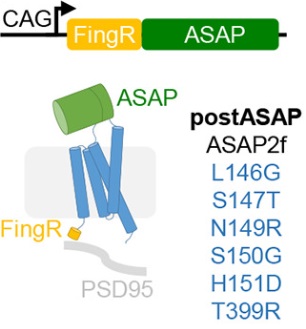postASAP
Type: Molecular / Cellular,
Keywords: Dendritic spines, Synapse, Dendrites, Neuron, Cortex, Postsynaptic density, Post-synaptic, Voltage imaging, Two-photon, Voltage sensor

Genetically-encoded voltage sensor targeted to dendrites and spines
This new tool, a genetically-encoded voltage sensor (GEVI) was modified for enhanced sensitivity and targeted to dendrites and dendritic spines by adding a nanobody against PSD95 (FingR.PSD95). With this voltage sensor, named postASAP, we are capable to measure voltage signals under two-photon microscopy in vivo in pyramidal neurons of the mouse cortex. With postASAP, we can detect in living animals backpropagation of action potentials, dendritic activity, and isolated synaptic potentials in dendritic spines.
* Two-photon voltage imaging of synapses
* Voltage imaging of dendritic trees
*Measurement of dendritic computation and synapses activation in vivo.
* Spine voltages measurement in vivo.
* Dendritic voltage dynamics in vivo.
* Compartmentalization of voltage in dendritic spines.
*Mice
* Measurement of voltage in individual synapses and thin dendritic trees.
* Could be combined with optogenetic actuators.
* Recommended to use only with sparse labeling for measurement of individual spine voltages.
*Cornejo et al. 2021, Voltage compartmentalization in dendritic spines in vivo, Science. doi: https://www.science.org/doi/10.1126/science.abg0501
*Plasmids will be available through Addgene.
Rafael Yuste, Professor of Biological Sciences
Department of Biological Sciences, Columbia University, New York, USA
TEAM / COLLABORATOR(S)
Victor Hugo Cornejo, Postdoctoral Scientist, Columbia University
Netanel Ofer, Postdoctoral Scientist, Columbia University
FUNDING SOURCE(S)
NIH R01NS110422
NIH R34NS116740
NIH R01MH115900
PEW Latin American Fellows Program in Biomedical Sciences

